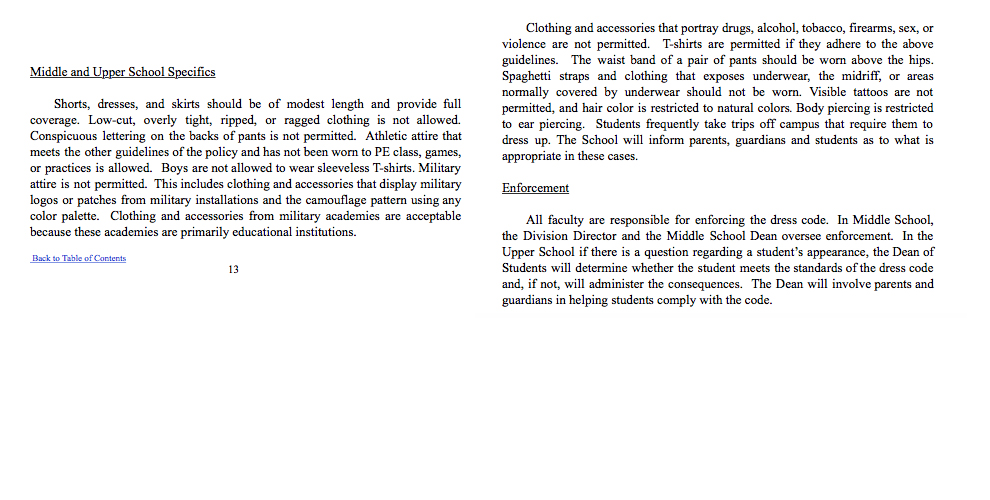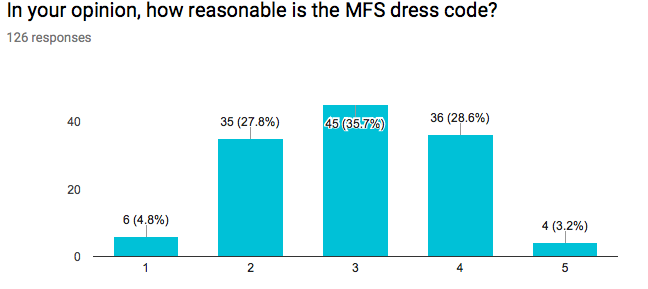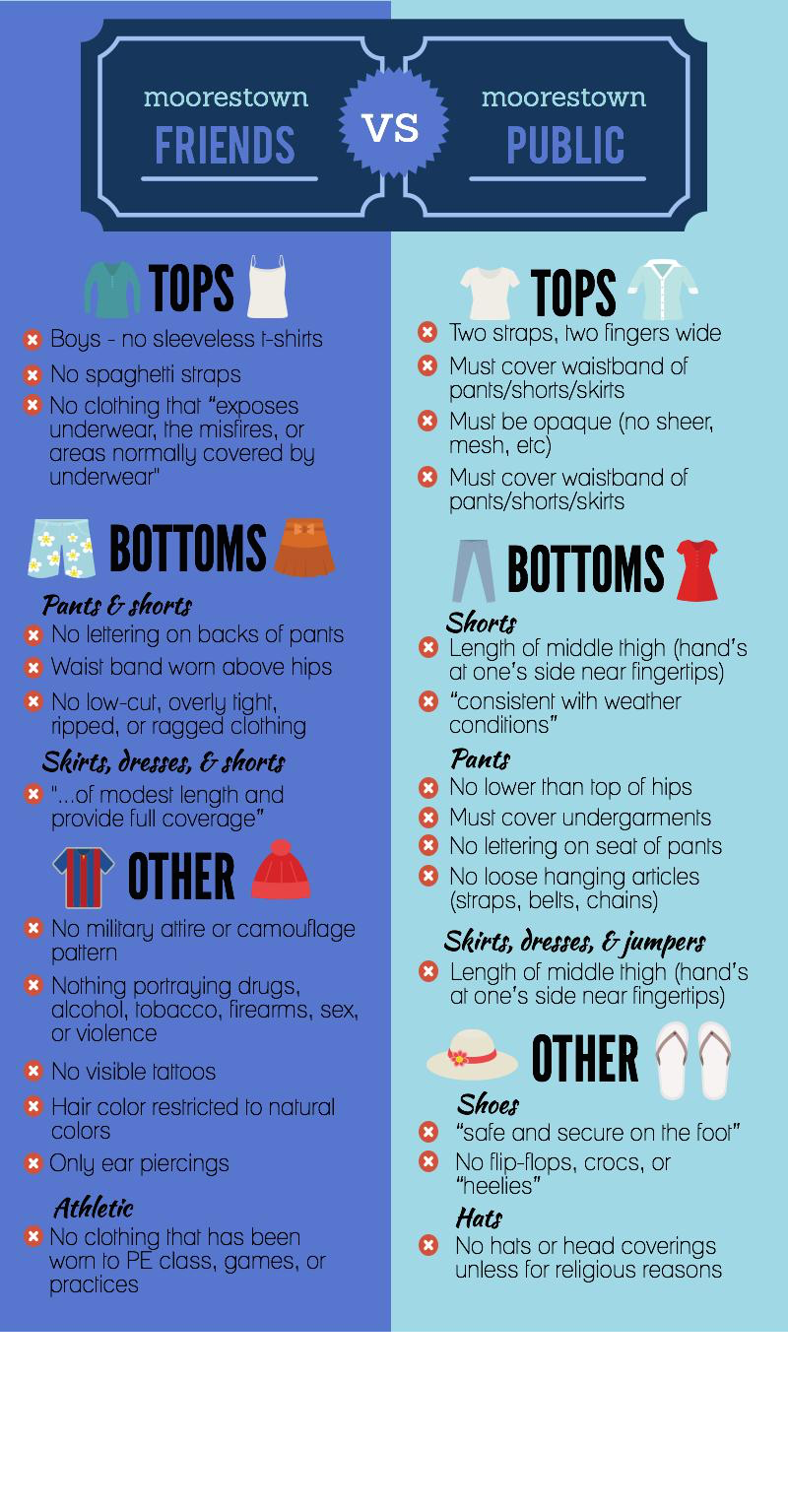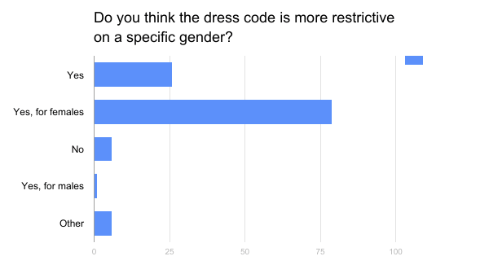Cracking the Code: An In-Depth Look at the MFS Dress Code
By Chloe Jones, Yashnoor Kaur, Julia Holliday and Kayleigh Schweiker
June 9, 2017
[The goal is] to represent the school well, and we don’t want people to look the same, we want their individuality, but we also have a dress code.
—Michael Brunswick
Student discussion regarding the MFS dress code seems to run on a seasonal cycle, arising as a topic of controversy every spring as students switch their winter sweaters for their spring shorts. This year was no different — from bralettes, ripped jeans, and other modern fashion trends that often violate the dress code, to the methods of enforcement of the school’s rules, to the very societal “norms” and gender roles suggested by the code itself — both students and faculty are affected by the dress code every single day. WordsWorth has taken an in-depth look at the key issues affecting the MFS community in relation to the dress code.

Our Current Dress Code ...
... is around 18 or 19 years old, according to Dean of Students Michael Brunswick. “It was just before I became Dean, so probably right in there,” he described. Additionally, the code was written by a committee of students, faculty, administration, and parents. The goal of the dress code, according to Brunswick, is built on the fact that MFS is a preschool through 12th grade school, and receives numerous visitors coming through the school on a daily basis.

While student opposition has been strong on a seasonal basis, actual efforts to change the dress code itself have been minimal. Senior and Co-Agenda Clerk Maura DiVentura described discussions of the dress code in Agenda in recent years: “People do have issues with it, but whenever it’s brought to Agenda, people don’t really want to do anything about it.” DiVentura also added that she believes our dress code is “pretty lenient” for a high school.
While the dress code may be outdated, considering it is as old, if not older, than our Seniors today, the majority of MFS students regard the dress code as “reasonable” on a scale of 1 to 5, as WordsWorth observed in a survey of 127 students.

Teacher Committee Established
A committee of MFS teachers and faculty members has recently been established in response to issues surrounding the dress code. Religion Department Chair Dan Christy Randazzo described the goal of the committee: “The goal is to revisit the dress code,” he said. “It hasn’t been looked at in a while, and see if the concerns of the people...whenever the dress code was reimagined several years ago, to see if that actually still applies, if we have changed, where we want to go with the dress code, and if that fits issues of current fashion, issues of where we as a faculty are now, issues of where the school is, and if dress codes are actually something we want to engage in. We are open to all questions,” he concluded. Looking forward, Randazzo said that the committee will likely be meeting regularly for the next few months.
May the Enforcement Be With You
One of the largest issues relating to the dress code has been the inconsistency and the means of enforcement. On a scale of one to five, five being very consistent and one being very inconsistent, 49.6% of the 127 MFS students polled by WordsWorth labeled MFS’s dress code as “very inconsistent.” Additionally, 29.9% voted similarly on the inconsistent end, at a two. Only 3.9% described the code as five, being very consistent.

The issues with enforcement seem to lie with both the ranging willingness from teachers to enforce the rules, contributing to an inconsistency in who is dress-coded and the appearance that a select population of students are frequently dress-coded, as well as the context of the interaction between a faculty member and the student being dress-coded.
The specific method of enforcing the rules varies among teaches as well, from waiting after class for a one-on-one conversation on the appropriateness of an outfit, to publically reprimanding the student in the hallway. These public interactions, where a student is criticized on their outfit and and appearance in an open setting can be embarrassing.
While opposition to the dress code at MFS seems to arise seasonally, Brunswick outlined how he deals with the pushback against the code as well as how he enforces the rules. Starting with an announcement, Brunswick tries to “let it go as far as I can where I’m just talking to individuals.” Then, if complying with the dress code becomes a general problem, he would make an announcement to the entire school, like after Meeting for Worship. “Then, if there are consistent offenders, then talk to the advisor to call home, or I’ll call home,” Brunswick explained.
Teacher Gap
While the code itself states that “all faculty are responsible for enforcing the dress code,” the level of commitment to enforce the rules seems to vary among faculty, as well as confusion as to what each faculty member’s role in the enforcement is.
While History Department Head Clark Thomson has informed students in the past that their attire may have been “inappropriate,” he expressed confusion relating to the enforcement of certain fashion trends.
Certain things that are unacceptable at one point become fashionable and accepted in society later. I use ripped jeans as an example - you’re not allowed to have ripped jeans, but ripped jeans are now a style, so I’m not sure what my role is in regards to ripped jeans.
—Clark Thomson
Whereas math teacher Sarah Kelly describes herself as "a firm believer in pointing out the necessary, across the board.” Recognizing popular trends in fashion, Kelly explained what she looks at when dress coding a student: "I have to be mindful of the fact that we have rules in place for a reason, and so I always try to approach it from a standpoint of identifying it as a violation, rather than it being inappropriate.” In addition, she tries to stay consistent by communicating with Brunswick when she is unable to talk to a student one on one.
History teacher and Gender Equality Forum advisor Eliza McFeely expressed opposition to the dress code and what it suggests about our school community. “I think we need to have a serious conversation about the issues stemming from the dress code, such as who is at fault if someone is distracted by someone else’s clothing,” she said. She would argue, in this case, that it is the ‘distractee’s’ fault, as opposed to the ‘distractor.’ McFeely also described the benefits of a gender neutral dress code for WordsWorth; “It’s simple fairness that stems out of the fact that most dress codes, ours included, single out girls for behavior they aren’t even involved in,” she explained. Overall, she believes in treating girls “as students, not like a sex object,” as both the dress code and the behavior stemming from it may suggest.
I think it speaks to the fact that we will view women and girls as sexual first and human second. And we should stop.
— Eliza McFeely
Brunswick explained how he tries to make the enforcement of the dress code more comfortable for teachers; recognizing that some teachers may be uncomfortable addressing what a student is wearing, he suggests that they send him an email. “I’ve asked them actually to, if they’re uncomfortable addressing it, to email me, and then if I’m able to go find that person and be like yes or no, or caution them,” Brunswick said.
In addition, Brunswick explained how he recognizes the age of the dress code and the current and evolving fashion trends. “There are things with jeans and frays that are now sold, and things like that we are a little more lenient on,” he said. While ripped jeans are against the dress code, he tries to use judgement while keeping in mind trends. “But when you have these big gaping holes in the pants, that really breaks the trust and the code itself,” he said, addressing the fine line between the amount of rips in an appropriate pair of jeans.
So while people may see that an inconsistency, I see it as us being lenient to the trends and things like that.
—Michael Brunswick
English teacher Dan Sussman described for WordsWorth his role in the community in regards to enforcement, especially as a new teacher. “I understand my role is supposed to be to enforce school policies,” he said. However, he does not dress code students.
I don’t always or often feel comfortable enforcing the dress code. See, one layer is I have ethical problems with it.
—Dan Sussman
Sussman also explained that with the dress code, there are problems relating to his values, and therefore he “doesn’t really dress code people.” As a new teacher, Sussman also outlined how he was introduced to his role of enforcing the rules: “I don’t recall if i was given a face to face message about that,” he said. However, faculty members are required to read the handbook, and sign a paper asserting that they have read it. Sussman described that he has read the dress code itself, so he is familiar with the rules.
Along with Sussman, Randazzo joined MFS as a new faculty member this year. In regards to his introduction to the his role of enforcing the dress code, Randazzo said, “We discussed it, briefly, in orientation, and then since then it has come up in numerous other settings, so we’ve had conversations about the dress code, especially in the Upper School. I particularly, because of my position in the school, have had opportunity to engage in that.”
Method of Enforcement
Junior Anna Immaneni described her experience being dress-coded by a teacher for WordsWorth: “I was walking in the senior hallway… and he dress-coded me publicly.” Immaneni said this was because “[he] thought it showed too much cleavage.” She described making sure the shirt she wore the very next day was “appropriate,” but was dress-coded again.
I was walking to Hartman and he was walking by and he kind of publicly again said ‘C’mon, put on a sweatshirt!'
— Anna Immaneni
Immaneni expressed her issue with the method of public enforcement of the dress code, like in her experience, because it “promotes slut-shaming,” as well as embarrasses the student.
In addition, Immaneni noted that body types vary - and girls with different body types may wear the same shirt and some will be pointed out, whereas less “curvy” girls will not. “It degrades girls and makes people look at girls in a certain way,” she told WordsWorth, highlighting the fact that the way teachers enforce the dress code is important for the entire community.
Consistency
While the majority of students regard the dress code as “reasonable,” the majority also regard the enforcement of the code as “very inconsistent.” While some teachers take their duty of enforcing the dress code seriously, some faculty do not feel comfortable or choose to not dress-code students. In addition, the common method of publically dress-coding a student can be more than embarrassing and uncomfortable for students.
Brunswick described how he tries to remain consistent for WordsWorth: “I try to have my standard of, going back to the ripped jeans, if you have a couple frays here and there, and a couple holes that are small or cut, I’m okay.” Despite this example breaking the dress code, Brunswick works to understand the trends of today, while maintaining a standard to dress-code students by. “Consistency, especially with the dress code, is a very fine line of being inconsistent or being consistent,” he said.
Bralettes: An Uplifting Tale
No matter how amusing it is to hear Brunswick pronounce the word “bralette,” it is a fact stated by Brunswick himself that bralettes are against the MFS dress code. This interpretation has angered many students, particularly due to the fact that bralettes have transitioned into fashion because of the bad rap surrounding the visibility of bra straps. In addition, bralettes have become a prominent fashion trend, sold in almost every popular clothing store.
Interestingly, bralettes are not entirely new; students at MFS have been wearing bralettes since last spring, when the trend first started. However, bralettes have peaked in popularity this spring.
WordsWorth polled 127 MFS students, and when asked what they would change about the dress code if they could, numerous students commented that they wished the code allowed visible bralettes. Commenting on the practicality of shopping, another student said, “Bras that 100% do not show are hard to find.”
Another student added, “I would allow bralettes to be shown because they are worn to be showed off or cover you more.”
And while bralettes are considered just another “undergarment” in terms of the dress code, some students argued against this. “Bralettes cover bras. They are not bras. It is a style,” one student wrote.
Bralettes are not bras, and we shouldn’t be coded for having them showing. Everyone knows we’re wearing a bra, the world will go on if a strap is seen.
—Anonymous MFS Student
This goes along with the previous stigma surrounding visible bra straps, and bralettes were crafted in response to this phenomenon. Another student agreed, writing, “Let me wear a bralette because it’s not a bra!” Students even tackled visible bra straps, questioning why noticeable straps are a negative: “Basically spaghetti straps should be allowed and I think as long as you aren’t exposing your actual front of your bra, straps aren’t bad.”
Students even wrote about the effect the code has on women at MFS: “Shoulders and bra straps are not scandalous or distracting,” one student said, “and women shouldn’t have to dress to make sure the boys aren’t distracted.” Students surveyed also commented on the fact that the current methods of enforcement may contribute to the sexualization and objectification of women:
From what I have noticed, as staff dress-code girls publically, it allows boys to think they have the right to examine girls and critique them on what they wear, promoting slut shaming.
——Anonymous MFS Student
When asked if students had ever been “dress-coded,” 28.3% of students participating in the survey had been dress-coded before. Those answering “yes” were asked to add what they were dress-coded for - and multiple people mentioned “wearing” or “showing” a bralette. In addition, out of our survey sample of 127 students, 63% of the responses came from individuals who self-identified as female.
Dress Code Comparisons
As stated in the Moorestown Friends School Student Handbook, appropriate dress is defined as “neat and simple” and reflective of “modesty and moderation”. However, it is often debated what type of dress will likely elicit a talking-to by the administration. The school handbook states that bottoms worn by middle and upper schoolers “should be of modest length and provide full coverage,” while “low-cut, overly tight, ripped, or ragged clothing is not allowed.” While the usage of the word “modest” is vague enough by itself, the phrase “full coverage” exudes the same sense of ambiguity, and begs the question - full coverage of what? While some “low cut” tops (another ambiguity - what constitutes “low cut?” Should one be punished for wearing a V-neck?) may provide full coverage of the stomach area, they may be considered too “low”; on the other hand, while a turtleneck may be long sleeved and cover all cleavage, it may be cropped, thus showing midriff.
Additionally, there is no definition provided for “ragged” or “overly tight” clothing, leaving the students to worry about whether their band T-shirts or skinny jeans are permitted. The dress code continues, stating: “Conspicuous lettering on the backs of pants is not permitted. Athletic attire that meets the other guidelines of the policy and has not been worn to PE class, games, or practices is allowed. Boys are not allowed to wear sleeveless T-shirts. Military attire is not permitted.” Speaking to enforcement, the standard dress code states, “In the Upper School if there is a question regarding a student’s appearance, the Dean of Students will determine whether the student meets the standards of the dress code and, if not, will administer the consequences,” but the dress code fails to highlight the likely consequences a student will receive upon being “dress-coded”. Will it be a talking-to? A warning? A detention? Due to the dress code’s ambiguity, students are left to wonder how their clothes will be perceived in the eyes of the Dean and ponder the possible consequences they may receive.

Friends Select School, a fellow Quaker high school, exhibits a dress code much like our own. The mission of the FSS dress code is to “require that students be dressed in a manner that reflects the school’s values and mission, demonstrates respect for itself and the community, and promotes focused teaching and learning.”
Offering specifics about what is appropriate, the FSS dress code states that “clothing must not: contain writing or images that include direct or indirect references to violence, profanity, sexual issues, alcohol, or drugs, include military dress, camouflage or military logos, reveal undergarments, include halter tops, tube tops, off-the shoulder shirts, spaghetti straps, or pajamas, or exhibit superheroes.” There is relatively little ambiguity present in the FSS dress code, as each article of clothing that is prohibited is clearly stated. On enforcement, the dress code states: “Students who do not follow these guidelines or who do not follow reasonable standards of decency in their choice of school attire may be asked to change clothes, be sent home, and/or receive notification. The administration and faculty reserve the right to interpret the dress code as needed”.

Though the Shipley School is in our sports division, they are not a Quaker school - perhaps this is why their dress code seems to differ so greatly from the FSS and MFS dress code. Though their stated purpose for the dress code is much like our own (“The Shipley community expects that its members will adhere to certain standards of neatness, modesty, and cleanliness.
Dress should be appropriate for an academic environment and should reflect a seriousness of purpose”), the dress code states: “Clothing should not be distracting, overly casual, inappropriately revealing (no visible undergarments), or considered offensive by the Upper School Administration”. From an outside perspective the term “overly casual” seems objective, and the prospect of a student’s dress being deemed “offensive” by the Upper School Administration seems ominous.
Further, the dress code declares: “Leggings may be worn, provided they are worn with a garment that sufficiently covers the student’s bottom. In other words, leggings, Lulu Lemon and yoga pants are not appropriate pants for school by themselves; they may be worn as tights under an appropriate top, tunic or dress which sufficiently covers the student’s bottom. Students who wear leggings of any variety without a top, tunic or dress that fully covers the bottom will be asked to immediately change or find proper attire.” For many students at MFS, yoga pants/leggings are a comfortable go-to to meet fashion trends while feeling comfortable - this facet of the Shipley dress code presents a stark contrast with our own.
The dress code continues: “Please note that T-shirts, tank tops, athletic shorts, sweat pants, hats or caps of any variety, workout gear, and bare midriffs are prohibited. Such items should be reserved for Shipley sporting events.”
Compared to our own dress code, the Shipley School’s dress code seems to prohibit casual dress and promote fancier and more business-like clothing - a topic on which the MFS dress code seems to disagree.
Pop Culture & Trends
One of the struggles for MFS students following the dress code is finding clothing that complies with the outlined rules. Modern fashion trends often take over clothing stores, such as crop tops or off-the-shoulder shirts and dresses, which makes shopping for dress code appropriate clothing considerably difficult.

Many female students at MFS are calling for an update of our dress code for many reasons, but mainly because the code doesn’t allow many trends to be worn to school. Some of these trends include bralettes, off-the-shoulder tops and dresses, ripped/destroyed jeans, and slightly ripped shirts and dresses.
To see what you can buy that complies with the dress code, WordsWorth went online to popular clothing stores. We started with PacSun. On the “new arrivals” page, we had to scroll down for a long time before there was anything acceptable for school.
Then we found a homepage that stuck out - Hollister. It read, “Skin is in! Bare a little in our new off the shoulder crop tops.” The Forever 21 homepage was similar. Three of the four dresses shown were off-the-shoulder, and the other had spaghetti straps.

Gender Roles
WordsWorth polled students, asking if they thought the dress code was more restrictive on a specific gender. Out of 127 responses, 106 individuals responded with a yes, and 79 of those responses specified that it was more restrictive on female. Only one response said that it was more restrictive on males.

While other schools, including Friends Central and Moorestown Public, have gender neutral dress codes, the MFS dress code is not far off from being gender neutral, aside from the clause saying boys are not allowed to wear sleeveless T-shirts. McFeely described the benefits of instituting a gender neutral dress code: “It’s simple fairness that you should...it stems out of the fact that most dress codes, ours included, single out girls for behavior they aren’t even involved in.”
Overall, WordsWorth was able to look at student issues with the dress code, with a focus on the inconsistency and method of enforcement of the rules, specific trends such as bralettes and ripped jeans, and the commentary the dress code makes on gender roles in society. Dialogue both within and between students and faculty has begun, tackling the many issues and concerns with the dress code within the MFS community. While a faculty committee has already been established, MFS student government has discussed in Agenda the possibility of establishing a student committee in September, hoping to continue the seemingly seasonal dress code debate and modernize the decade old dress code.




